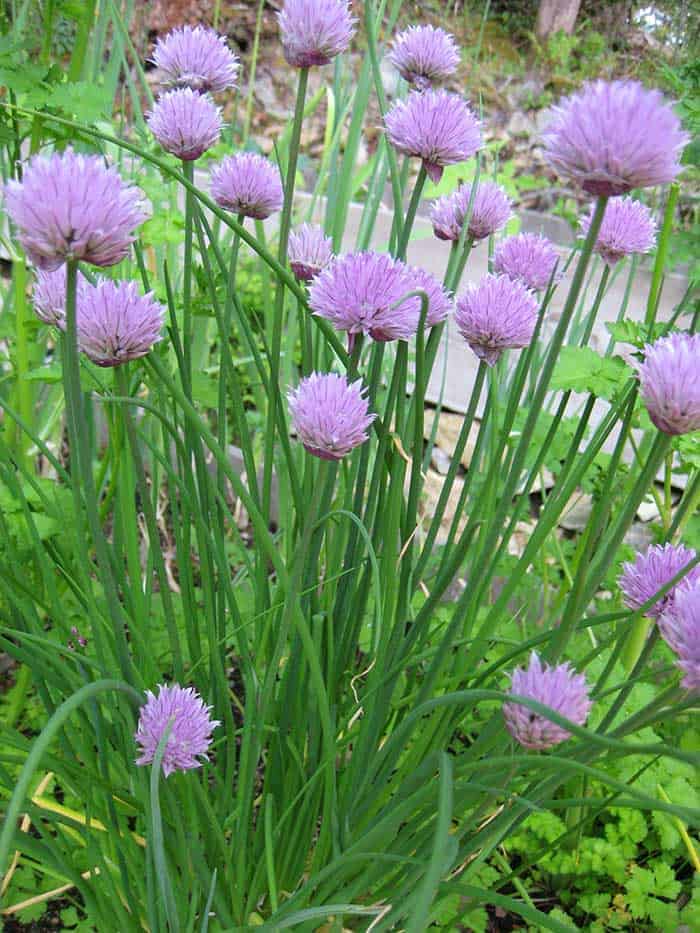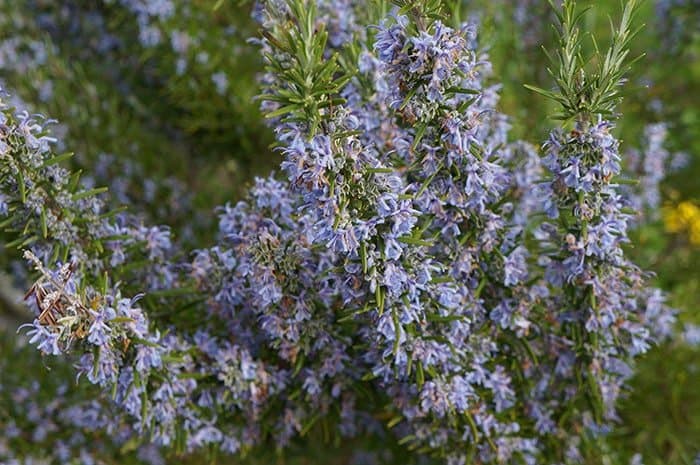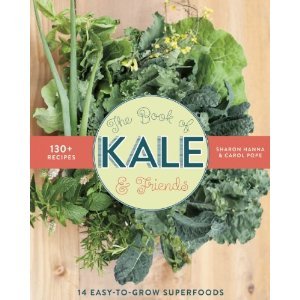When you plant your garden this spring, think multi-purpose. Consider what plants grow without fuss, look gorgeous, add fabulous flavour and health-boosting goodness to the meals you prepare — and, all the while, support our besieged bees.
This is what my co-author Sharon Hanna and I pondered for more than a year in our gardens while writing The Book of Kale & Friends: 14 Easy-to-Grow Superfoods. We asked ourselves what edibles could easily be grown to add nourishment and flavour to our daily life, and also help sustain our struggling pollinators.
As gardeners, we have an opportunity to do a lot with a very little: just a few pots or a scrap of land is all it takes to plant up a pretty and useful patch of perennial edibles. And the more of these worker plants the better — an abundance of them allows us to scissor-snip some for culinary use while leaving the remainder to bloom and provide pollen for our essential and endangered bees.

CHIVES (Allium schoenoprasum)
There’s no surer sign of spring thaw than chives starting to poke out of the ground. A few snips from a patch of chive plants — with their oniony essence and edible flowers — will fancy up any omelette, baked potato or bowl of soup. Meanwhile, you will be getting disease-fighting goodness from this vitamin-rich, antiviral, antibacterial perennial powerhouse. And, as Sharon likes to point out, chive blossoms are compound flowers, meaning each consists of many, many tiny florets — bees and other pollinators are attracted to them because they can gather a lot of nectar without having to expend energy flying to many different flowers.
To grow chives, sow seeds or plant seedlings in the spring after the last expected frost. Or divide clumps in spring when barely emerging — they’ll increase quickly. If you harvest regularly, you’ll have an ongoing and succulent supply for spring and summer, and into late fall—simply raze a clump to the ground with a snip of your scissors or swish of your paring knife, and then watch it grow back like mad. This is a crop that dies back come frost, so at the season’s end—before the plants lose vigour — level your chives to the ground and freeze snippings for winter soups. If you grow chives in a pot and can store it indoors in a bright spot or in a greenhouse, you’ll have an extra-early harvest next spring.

MINT (Mentha spp.)
Mint is super easy to grow and useful beyond measure, repelling bad bugs and luring good ones, sweetening our digestive health and, all the while, making us happy with its scent. Add mint to the teapot, or to tabbouleh, raita, braim, or potato or fruit salads, breathing the scent in deeply while chopping it finely.
Easily grown from divisions, root cuttings or seed, mint can be planted any time the ground isn’t frozen solid. It thrives in dampish soil in part shade, with protection from very hot sun. Mint can get a bit straggly, so give it frequent haircuts. To contain its rambunctious nature, plant it in buckets or plastic nursery pots at least 10 inches (25 cm) deep and with the bottoms cut out. Simply sink the whole works into the soil.
Mint attracts a plethora of beneficial and pollinating insects when it’s in bloom, particularly bees, syrphid flies (hoverflies), lacewings and butterflies.

OREGANO (Origanum spp.)
Remarkably rich in antioxidants, this antibacterial herb also abounds in vitamin K, minerals and omega-3 fatty acids, and is gorgeous in the garden and a super supporter of bees. The ultimate addition to Mediterranean cuisine, oregano is fabulous fresh, frozen in ice cubes for soups or dried—in fact, drying is one way to maximize its flavour for cooking. Oregano is most pungent just after buds form, but before blossoms open. Toss it into vinaigrettes, meatballs (or meat-substitute balls), soups, stews, salads, or onto pizzas or grilled cheese.
Sow seeds or plant seedlings in the spring after the last expected frost. Try growing oregano in a terra-cotta pot, hanging planter or rock garden.
There are several Origanum species. Origanum vulgare ssp. hirtum (a.k.a. Origanum heracleoticum) is the real Greek oregano and the most intensely flavourful. Oregano thrives in sun and needs well-drained lean soil, can self-seed prolifically and is drought tolerant.

ROSEMARY (Rosmarinus officinalis)
The earthy, aromatic scent of rosemary’s glossy green foliage whisks us to Mediterranean climes in a heartbeat. With a little TLC, it’s a wonder crop for temperate climes, too, offering us antibacterial and antifungal protection when we eat it.
For stews and roasted meals, rub the lovely fresh rosemary leaves off the stem, then chop and sprinkle on your food. Add to stuffings, white-bean soup with lemon, and even jams, honey or shortbread.
However you relish rosemary, you’ll benefit hugely from its antioxidant properties, multiple vitamins and minerals. Also anti-inflammatory, iron-rich and a remedy for colds, this herb deserves a place of honour in your garden and on your plate.
Rosemary grows well in Zone 6 and above, but needs excellent drainage to survive the winter. Position it on a south-facing slope, if possible, where it will have some winter protection. Mulch with leaves or straw. In colder climates, grow it in a pot and move it inside the house or a greenhouse through winter.
Snipping rosemary for culinary use should keep the lower branches bushy. Go easy on taking cuttings in fall and winter though, as this can set the plant back or even kill it — just take a few when you need them, and take extra snips during the growing season to dry for winter use.

THYME (Thymus vulgaris)
Time after time, I have waxed on about thyme. This garden superhero is bountiful, bee-friendly, beneficial to health, beautiful and a boon in the kitchen — plus, it’s almost impossible to kill. Trim it regularly to keep it tidy and use the clippings in the kitchen. Every time you enjoy this herb with your meal, you’re topping yourself up with antioxidants, minerals, vitamins B6, C and A, and disease-fighting thymol oils.
Thyme is fabulous fresh, and the tiny thyme leaves can be pulled off the woody stems and strewn into wraps, sandwiches, oven roasts and soups. Often, I throw them onto goat’s cheese on toast for a quick, tasty snack. Toss clouds of tiny thyme confetti onto anything to be cooked on the barbecue or in a roasting pan: tomatoes, peppers, onions, salmon, veggie burgers. And if you’re thinking of the taste of dried thyme purchased in the supermarket, don’t! Fresh thyme is more aromatic, but in a subtler way. Use three times as much fresh thyme as you would dried in any recipe.
Sow seeds or plant seedlings in the spring after the last expected frost; thyme also grows well from cuttings or by layering. Thyme is a gorgeous “spiller” for containers, rock walls and hanging baskets. To attract pollinaters and repell plant predators, plant thyme to drape over the sides of raised vegetable beds. Resplendent in tiny blossoms, thyme is much visited by bees throughout the growing season.

Introducing Carol Pope
Carol Pope is co-author (with Sharon Hanna) of the newly released The Book of Kale & Friends: 14 Easy-to-Grow Superfoods (Douglas & McIntyre). She has 25 years of experience in editing, garden writing and organic gardening. As editor of GardenWise magazine for more than a decade, and editor of gardenwiseonline.ca, Carol focused on organic gardening in British Columbia. She was contributing editor to several gardening bestsellers and is garden series editor of more than 15 books and guides on organic gardening.
